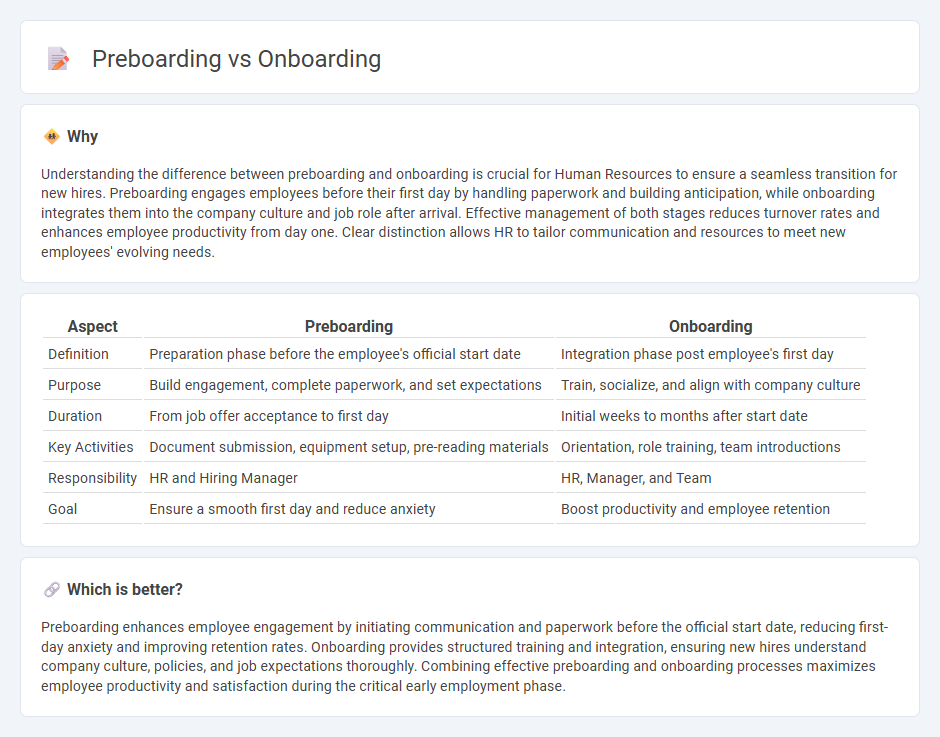
Preboarding begins the employee engagement process before the official start date, focusing on paperwork completion, company culture introduction, and initial communication. Onboarding follows as a comprehensive integration phase, involving training, role clarification, and socialization within the team to ensure productivity and retention. Discover how strategic preboarding and onboarding practices can enhance workforce performance and satisfaction.
Why it is important
Understanding the difference between preboarding and onboarding is crucial for Human Resources to ensure a seamless transition for new hires. Preboarding engages employees before their first day by handling paperwork and building anticipation, while onboarding integrates them into the company culture and job role after arrival. Effective management of both stages reduces turnover rates and enhances employee productivity from day one. Clear distinction allows HR to tailor communication and resources to meet new employees' evolving needs.
Comparison Table
| Aspect | Preboarding | Onboarding |
|---|---|---|
| Definition | Preparation phase before the employee's official start date | Integration phase post employee's first day |
| Purpose | Build engagement, complete paperwork, and set expectations | Train, socialize, and align with company culture |
| Duration | From job offer acceptance to first day | Initial weeks to months after start date |
| Key Activities | Document submission, equipment setup, pre-reading materials | Orientation, role training, team introductions |
| Responsibility | HR and Hiring Manager | HR, Manager, and Team |
| Goal | Ensure a smooth first day and reduce anxiety | Boost productivity and employee retention |
Which is better?
Preboarding enhances employee engagement by initiating communication and paperwork before the official start date, reducing first-day anxiety and improving retention rates. Onboarding provides structured training and integration, ensuring new hires understand company culture, policies, and job expectations thoroughly. Combining effective preboarding and onboarding processes maximizes employee productivity and satisfaction during the critical early employment phase.
Connection
Preboarding and onboarding are interconnected processes essential for employee integration, where preboarding focuses on engaging new hires before their start date through paperwork completion and initial communication, while onboarding continues this integration by providing training, cultural orientation, and role-specific guidance. Effective preboarding reduces new hire anxiety and accelerates productivity by familiarizing employees with company policies and expectations prior to day one. Seamless transition between preboarding and onboarding enhances employee retention and satisfaction by fostering early engagement and clear alignment with organizational goals.
Key Terms
Orientation
Orientation during onboarding facilitates new hires' integration by providing essential company policies, role expectations, and team introductions. Preboarding focuses on initial engagement, sharing resources such as employee handbooks and setting up IT access before the official start date. Discover more about optimizing orientation strategies for successful employee assimilation.
Documentation
Preboarding involves gathering and submitting essential documentation before the official start date, such as identification, tax forms, and compliance certifications, streamlining the onboarding process. Onboarding continues this process by verifying these documents, completing any remaining paperwork, and integrating digital records into HR systems to ensure compliance and readiness. Explore comprehensive best practices for managing documentation efficiently during both stages to optimize employee experience.
Engagement
Preboarding initiates employee engagement before the official start date by providing essential resources and fostering early connection to company culture. Onboarding builds on this engagement through structured training, role clarity, and continuous support to enhance productivity and retention. Explore effective strategies to maximize engagement throughout both preboarding and onboarding phases.
 dowidth.com
dowidth.com